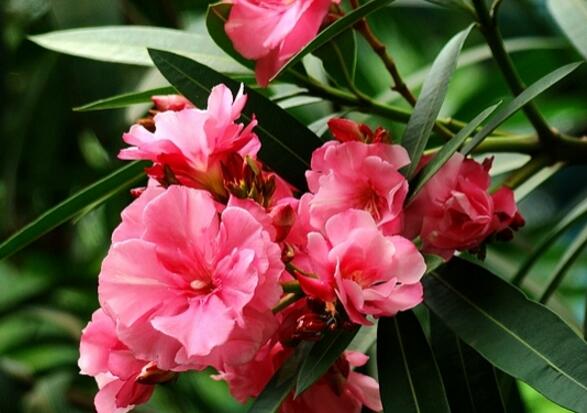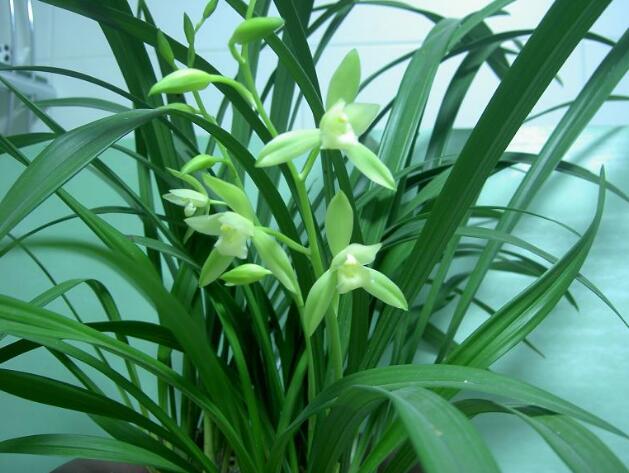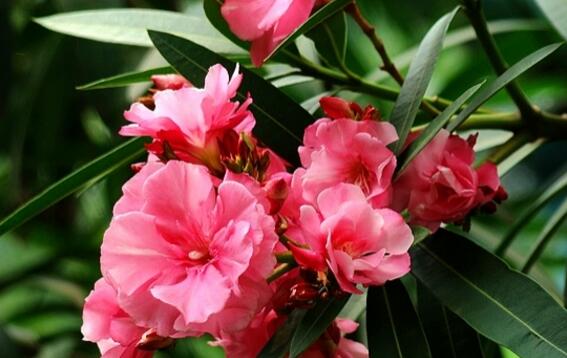How to cultivate oleander in pot, culture methods and precautions of oleander / highly toxic
For oleander, we should have heard that it is a long flowering, colorful plants, loved by many flower friends. In life, many people will raise oleander at home, but oleander body is highly toxic, so raise must pay attention to, that potted oleander how to cultivate it? The following is oleander breeding methods and precautions, very comprehensive, want to raise friends must see!
1. How to cultivate potted oleanders and create conditions

Although oleander is poisonous, there are still flower friends who keep it at home. They are very curious to know how to cultivate potted oleander. In this regard, we can create growth conditions according to the growth habits of oleander, such as slightly acidic soil, light illumination, appropriate water and fertilizer, etc. Specific in oleander breeding methods and precautions, we continue to look down.
Second, the cultivation methods and precautions of oleander
1. Soil, slightly acidic
How to cultivate potted oleander, first of all, naturally select soil. Oleander adaptability is very strong, so the soil requirements are not high, but want to raise oleander, it is best to raise it in fertile slightly acidic soil.
2, light, enough
According to the growth habits of oleander, it likes sunshine, so we should ensure that it can have sufficient light time, especially in the growth period, we must satisfy it.
Note: once the light is insufficient, or in the shade for a long time, although oleander will bloom, but the opening will be very few, and the color will be very light, seriously affecting the ornamental.
3, temperature, higher than 0℃
In oleander breeding methods and precautions, temperature is also what we need to pay attention to. It is understood that oleander likes warmth, so it is best to put it in the lee. However, oleander adaptability is strong, so as long as the temperature is not lower than 0℃, winter attention to antifreeze.
Note: Although oleander likes warm, but the temperature is too high also can not, this will seriously consume nutrients, so that the second year of growth and flowering will be very bad.
4, watering, see dry see wet
Oleander love humid climate, so potted oleander how to cultivate, watering is very important. It is understood that oleander likes water, but afraid of waterlogging, so when watering oleander, be sure to pay attention. In spring and autumn, watering to see dry see wet watering principle, keep pot soil moist can; in summer, oleander is in the growth period and flowering period, so the water demand is large, at this time we should water once a day morning and evening.
Note: when watering oleander must not be more, because once the basin water, it will lead to rotten roots appear, oleander leaves yellow will appear, serious will also affect the second year of flowering. Therefore, see dry see wet four words, everyone must remember!
5. Fertilization, once every 20 days
Fertilizer application: oleander like fertilizer, from the room to the flower fade (frost) can be applied every 20 days or so 1 thin liquid fertilizer. After the beginning of autumn oleander rapid growth, then every 15 days or so can be applied 1 fertilizer until before entering the house.
6, pruning, 4 times a year
How to cultivate potted oleander, pruning is also very important. If you want to raise oleander, it is best to prune it four times a year: one is after spring rain, the other is between July and August, the third is between October, and the fourth is winter pruning. In addition, pruning should also be carried out after flowering, otherwise the next year will have fewer flowers or even no flowers.
Third, the cultivation of oleander precautions
In the above oleander breeding method, has said a few need to pay attention to the place, I believe we have remembered. However, in addition to the above mentioned, there are three points that flower friends need to pay attention to: 1 is pests, 2 is poisonous. The precautions for oleander cultivation are as follows:
1. Diseases and pests
In the process of plant cultivation, it is very common to be infested by pests and diseases. Oleander is no exception, but it has strong adaptability and we can have sufficient time to deal with it. Among them, the main pests of oleander are: oleander aphid, pile wax scale; the main diseases are: brown spot disease, black spot disease, specific how to treat, in oleander pest control has a detailed introduction, here will not say more.
2. The whole body is poisonous
In oleander breeding precautions, there is one thing we must pay attention to, that is, oleander whole plant is highly toxic, human and animal ingestion is dangerous. Not only that, the fragrance of oleander can also make people lethargic, intelligence reduction; oleander stem and leaf skin, flowers and fruits secretion of milky liquid can also induce respiratory tract, digestive system cancer!
How to raise oleander oleander cultivation methods and precautions
Oleander leaves such as willow bamboo, red flowers burning, better than peach blossoms, is a famous ornamental flowers. How to raise oleander? Let's take a look at the cultivation methods and precautions of oleander.
The cultivation method of oleander:
1. Turn over
Potted oleander two years to turn the pot for soil 1 time, pot bottom can put a little feather hoof angle type long-term fertilizer. During the growth period, liquid fertilizer can be applied 1 to 2 times according to the growth. Oleander pruning tolerance, germination force, aging plants can be combined in spring pot for soil renewal pruning, all branches from the base cut off, promote its germination of new branches rejuvenation. General plants should also be moderately pruned in spring to maintain plant symmetry and strong tree vigor.
II. Trimming
Through pruning, the branches are evenly distributed, the flowers are big and the trees are beautiful. The top branches of oleander have the characteristic of one-third, which can be pruned and shaped according to needs. If you need a three-pronged nine-top shape, you can cut off a part of the top of the three-pronged, and you can separate the nine-top. If you need nine top eighteen branches, you can leave six branches, cut off from the top leaf axils, you can produce eighteen branches. Pruning time should be after each flowering. In the north, oleander blossoms from April to October. The flowers that bloom should be removed in time to ensure nutrient concentration. It is generally divided into four times of pruning: one is after spring grain rain; the second is July and August; the third is October; and the fourth is winter pruning. If you need to flower indoors, move it indoors at about 15 ° C in the sun. Prune immediately after flowering, otherwise the flowers will be few and small, or even not flowering.
III. Root thinning
The capillary root of oleander grows faster. Three-year-old oleander, planted in a pot with a diameter of 20 cm, can grow roots before July of that year, forming a ball, hindering the penetration of water and fertilizer, affecting growth. If the roots are not thinned in time, wilting, falling leaves, death and so on will occur. The best time for thinning roots is from early August to late September. At this point the roots are dormant, and it is a good opportunity for thinning roots. Root thinning method: use a quick shovel to cut off the yellow hairy roots around; then use a three-pointed hook to thinning along the taproot. About half or one-third of the yellow hairy roots are thinned and replanted in pots. After thinning the roots, put them in the shade and irrigate them with water to keep the basin soil moist. Keep shade for about 14 days, then move to sunshine. Field planted oleander, in mid-September, should also be in the main stem around the yellow hairy roots cut. After root cutting, water and apply thin liquid fertilizer.
IV. Topdressing
Oleander is a kind of flower that likes fertilizer water, neutral or slightly acidic soil. Fertilization should be kept about 20% of the pot soil organic soil manure. If it is used for chicken manure, 15% is enough. Fertilization time: once before Qingming Festival and once after autumn equinox. Method: Dig a circular trench around the edge of the pot, apply fertilizer and cover with soil. After fertilization in Qingming, apply soybean cake water retting with water every ten days or so; after fertilization in autumn equinox, apply soybean cake water or peanut cake water or ten times chicken manure solution every ten days or so. Without the above fertilizer, it can be used to add water five to seven times more than the human urine decomposed for more than seven days, pour it along the edge of the basin, and then pour water thoroughly. Nitrogen fertilizer, the principle is thin, light, less, frequently, to prevent burning rotten roots.
V. Watering
Proper watering is the key to good oleander management. Improper watering in winter and summer can cause leaves, flowers and even death. Pouring once a day in spring and once a day in the morning and evening in summer keeps the water content of the basin soil about 50%. The leaves should be sprayed frequently. Too dry, easy to fall leaves, wither. Winter can be watered less, but the pot soil moisture should be maintained at about 40%. Foliage should be washed with clean water frequently dust. If it blooms in winter, the room temperature can be kept above 15℃; if it does not bloom in winter, the room temperature can be reduced to 7~9℃ and placed indoors in a bright place without sunlight. The oleander planted outdoors in the north needs to be wrapped with straw to prevent freezing and cold, and remove cold objects before and after Qingming. Although oleander is easy to manage, it cannot paralyze.
Notes on oleander cultivation:
Oleander likes plenty of light, warm and humid climate conditions. It is also slightly cold-resistant, and can be overwintered in warm temperate areas without defoliation. Summer potted plants should be watered frequently, sprayed, keep the pot soil and environment moist, but must not be wet for a long time. Oleander also has a characteristic, as long as there is a drought dehydration or water accumulation, the lower leaves of the plant will soon all yellow, fall off, so watering should be timely and appropriate. After early spring strong pruning, we should pay attention to Le water to prevent root infection and decay. Timely cut loose basin soil, flower wither after timely removal, summer occasional aphid and red spider harm, available general pesticide elimination. Oleander whole plant is highly toxic, poisoning symptoms are nausea, vomiting, lethargy, arrhythmia, serious words even lose consciousness or death are possible, so the face of oleander, as long as appreciate it, do not do it!
The cultivation methods and precautions of oleander
Although oleander is poisonous and ornamental, there are still many flower friends who like to cultivate it. Apocynum terminal cymes, corolla funnel shaped, red or white, common in gardens. So how do you raise oleander? What do you need to pay attention to in the breeding process? Analyze to Xiaoqi to share the cultivation methods and precautions of oleander.
White oleander pictures
1. Cultivation method of oleander
1. Watering: Although oleander likes water, it is afraid of waterlogging. In case of continuous rainy days, the accumulated water in the basin should be dumped in time to prevent rotten roots. Too much watering, the leaves will fall off yellow, affecting the flowering of the following year. Spring and autumn season watering should see dry see wet, in order to keep the pot soil moist is appropriate. Summer is the period of vigorous growth and flowering of oleander, so it needs more water. It is advisable to irrigate water once a day in the morning and evening, and pay attention to spraying branches and leaves frequently to keep the leaves fresh and green. In mid-October, after entering the room, control watering, avoid excessive water, otherwise easy to rot roots, leaves, affect the growth of the next year.
2. Light: oleander likes sunshine, so it needs to be maintained in a sunny place during its growth, otherwise it will have less color.
3. Temperature: oleander should be planted in leeward and sunny places. In winter, people should freeze indoors. The room temperature should not be lower than 0℃. The temperature is too high, which consumes nutrients. It is unfavorable for the growth and flowering of the second year. If the outdoor temperature is high in winter, it can cultivate soil to keep warm.
4. Fertilization: oleander likes fertilizer, and thin liquid fertilizer can be applied every 20 days or so from the room to the flower (frost). After the beginning of autumn oleander rapid growth, then every 15 days or so can be applied 1 fertilizer until before entering the house.
5, pruning: oleander if not cut, the plant shape is too large, pretending to cluster cultivation to be on the branches or stems to be organized. Oleander germination force such as in the middle of the branch cut off, can be from its incision issued a majority of branchlets and affect the shape of the plant, so in principle must be cut off at the base of the branch when pruning.
6. Pests: Brown spot disease is an important disease on oleander. In the early stage of disease, spray 50% benomyl WP 1000 times or 25% carbendazim WP 600 times and 36% thiophanate-methyl suspension 500 times.
Peach oleander picture
II. Precautions for oleander cultivation
Oleander likes plenty of light, warm and humid climate conditions. It is also slightly cold-resistant, and can be overwintered in warm temperate areas without defoliation. Summer potted plants should be watered frequently, sprayed, keep the pot soil and environment moist, but must not be wet for a long time. Oleander also has a characteristic, as long as there is a drought dehydration or water accumulation, the lower leaves of the plant will soon all yellow, fall off, so watering should be timely and appropriate. After early spring strong pruning, we should pay attention to Le water to prevent root infection and rot. Timely cut loose basin soil, flower wither after timely removal, summer occasional aphid and red spider harm, available general pesticide elimination. oleander whole plant is poisonous, human and livestock eating is dangerous, should avoid planting near the well and drinking pool, facing oleander, do not start oh!
White oleander pictures
The above is the oleander breeding methods and precautions introduced, oleander breeding or a little knowledge, I hope to help you, oleander breeding precautions to keep in mind oh.
Recommended reading:
Is there a poison in the house that can be raised?
2 What is the meaning of oleander flower language
How to grow hibiscus flowers
4. The cultivation method of purple magnolia. Picture appreciation of purple magnolia
How do you manage your business and how do you manage your business?
- Prev

How to cultivate Jian orchid, the culture methods and matters needing attention / semi-shade culture
Jianlan is a common plant in people's life today, which has a very high ornamental value. How to raise Jianlan is also an issue that many people are more concerned about. in order to raise it well, we need to pay attention to it in many aspects. In the following, the culture methods and matters needing attention of Jianlan are introduced.
- Next

How to water oleander, if it is not dry or irrigated, it should be watered thoroughly / reduce the amount of water in winter
As a highly ornamental plant, oleander is highly poisonous, but its flowers and leaves are very beautiful, so many people keep it at home. Oleander has strong adaptability and does not require water and fertilizer, but if you want it to look better, watering is very critical. How to water oleander?
Related
- Fuxing push coffee new agricultural production and marketing class: lack of small-scale processing plants
- Jujube rice field leisure farm deep ploughing Yilan for five years to create a space for organic food and play
- Nongyu Farm-A trial of organic papaya for brave women with advanced technology
- Four points for attention in the prevention and control of diseases and insect pests of edible fungi
- How to add nutrient solution to Edible Fungi
- Is there any good way to control edible fungus mites?
- Open Inoculation Technology of Edible Fungi
- Is there any clever way to use fertilizer for edible fungus in winter?
- What agents are used to kill the pathogens of edible fungi in the mushroom shed?
- Rapid drying of Edible Fungi

